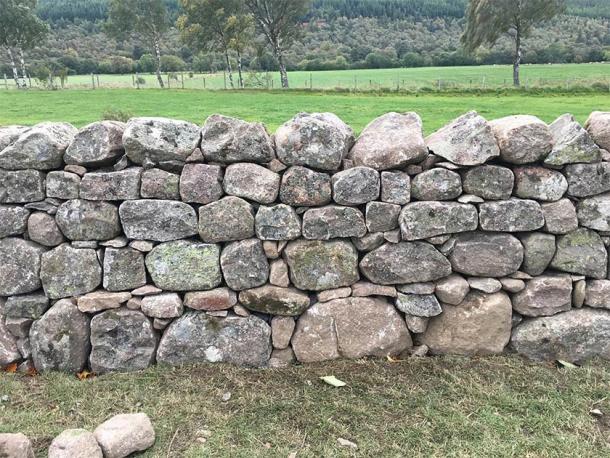
Saving the Forgotten Craft of Dry Stone Walling in Scotland
Dry stone wall building is one of Scotland’s oldest crafts, dating back as far back as 5,000 years ago, during the Neolithic period. Unfortunately, this ancient construction technique is disappearing. But now, two young craftsmen in Scotland are making a bid to save the ancient stone crafts from extinction.
The Legacy of Scotland’s Neolithic Walls
Britain has many different types of agricultural environments and throughout history each one required a different style of stone wall, depending on the types of stones found in any given area. Building styles that have emerged from place to place also vary due to the range of different raw materials: some were built using a small number of huge boulders, while others were made with thousands of tiny pieces of flat shale.
- Stepping Back in Time at Skara Brae: A Neolithic Settlement in the Heart of Prehistoric Orkney
- 6 Ways Roman Engineers Were Way Ahead of Their Time
- Is this How Ancient Megalithic Structures Were Made? MIT Scientist Move 25-Ton Blocks by Hand!
According to an article in Farm Collector, the oldest existent dry stone walls in Britain are located in Skara Brae in Orkney, Scotland. Dating back 3,500 years, these mark the transition from hunting-based lifestyles to a farming-based existence. These walls were built only with stones, and they were bound together with skill, because the artisans used neither concrete nor mortar to secure their work.

Dry stone walling is an ancient craft which is disappearing in Scotland. Martin Tyler and Luke De Garis are working to create a solid foundation for future generations of stone wallers. (Dry Stone Walling Perthshire)
Introducing the Saviors of Ancient Scottish Dry Stone Walling
Two young craftsmen, Martin Tyler and Luke De Garis, are making a bid to save the dying craft of building stone walls, or “dry stane diking” as it’s called in Scotland. Speaking to The Scotsman, 34-year-old Martin Tyler, who owns Dry Stone Walling Perthshire, said that “the skill is technical and complex to learn, but it provides walls that will last hundreds of years.” Luke De Garis, also 34, from Perthshire, was granted an apprenticeship through The Queen Elizabeth Scholarship Trust and Allchurches Trust, to train under Tyler. De Garis explains that the pair of craftsmen plan to continue working together after his training, adding that they hope their work will lay a strong foundation for future generations of dry stone wallers to build upon.
According to the Dry Stone Walling Association (DSWA), changes in farming practices and an ageing population of wall craftsmen, means “more than 70 per cent of the UK’s historic walls lie derelict.” With a lack of funding and just 31 qualified DSWA contractors working in Scotland, Tyler and De Garis are essentially saviors of the traditional skills associated with wall building in Scotland. Martin Tyler explains that the craft of wall building requires knowledge of architecture that takes time to master, which is why “it’s important dry stone walling work is carried out by someone who is qualified.”

One of the dry stone walls the pair have been working on. (Kirstie De Garis)
Dry Stone Walling: It’s a Balancing Act
When it comes to the actual process of building stone walls, Tyler told the Scotsman that “it can be a bit like a giant jigsaw puzzle, except you don’t have a picture to work with, and the individual pieces can fit into about 20 different places.” Most walls follow an A-shape with heavier stones along the bottom while smaller, lighter stones are laid at the top. No earth or mortar is used to bind the rocks together, and small filler rocks are chosen to fill the holes in between, meaning a wall’s integrity relies solely on balance, reflecting the training and craft skills of the builder.
Most very old walls in Scotland are actually “clearance walls,” made from stones that were cleared from the land in order for agriculture to occur. When lots of stones were discovered on a field, it was often easier to build a wall than to remove them. “Consumption walls” were named after the vast number of stones they can be said to “consume.” Not all dry stone walls in Scotland are as old as the clearance walls and most date to the 18th and 19th centuries when huge areas of land were given private ownership and enclosed. The Inclosure Acts (notably the General Inclosure Act of 1845, spelt with an “I” rather than the modern “e”) resulted in crippling restrictions for the poor, meaning traditional rights to graze livestock on common land were suddenly ended. Desperate for employment, poor folk from the countryside headed toward urban areas and this sparked the decline in wall building crafts, highlighting the importance of this renewed commitment to the dying craft.
Top image: Luke De Garis is the apprentice who has joined forces with Martin Tyler at Dry Stone Walling Dry to learn the ancient craft of stone walling, thanks to the Queen Elizabeth Scholarship Trust. Source: Kristie De Garis
By Ashley Cowie















